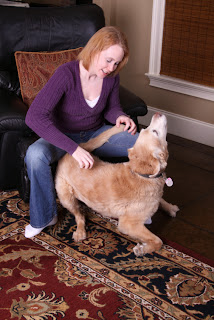Chris
Reeder, DVM, DACVD
Sometimes no matter how hard we try, a diagnosis of pruritic skin disease is frustrating.There are a few key questions and findings that may make life a little easier in dealing with the itchy dog. The skin as an organ has incredible powers. Not mystical or magical, those are confined to brain along with neurologic pathways to control motion and physiologic/psychologic processes. No, the skin has its own special powers. It acts as a physical barrier providing innate protection against the evils of the environment. Skin stretches and can transition from taut to lose, thick to thin, it controls water loss and temperature regulation, it acts as a sensory organ and to many animals, camouflage to help hide from predators or stalk prey. Skin truly is an incredible organ, though as incredible as it is, an Achilles’ heel does exist…..pruritus.
Pruritus is derived from the Latin prurire meaning to “itch.”
It is defined as the desire or reflex to scratch. Itching in the dog is one of the most common
presenting complaints from owners to the general practitioner, yet one of the
most frustrating and costly as well. There
is help, several key questions and findings may provide a starting point or diagnosis
as to why a dog is itching. Our first
step is the question the owner about the dog’s condition:
-
Age of onset of the itching
-
Duration of the itching
-
Other animals in the household affected
-
Housed indoor, outdoor or both
-
Travel history
-
Current and previously fed diets (including human
foods)
-
Seasonal history or exacerbations of itching
-
Previous medications, what worked and what didn’t work
-
Current flea/tick control products (other animals
treated)
-
Number of bowel movements daily
-
Loose, runny stools or any vomiting
Many animals who have a food allergy will present as young
dogs (<1 year of age) with loose or runny stools, >3 bowel movements
daily and may be refractory to glucocorticoid use. Other household animals are not affected and
this is typically non-seasonal with itching as a constant feature. Compare that to the typical dog with atopy
(environmental allergies) and we see that most of those dogs present first
between 1-4 years of age, have some seasonal pattern, respond to
glucocorticoids with a reduction of pruritus and no other animals in the
household are affected. The author’s
experience, along with many dermatologists, find that atopy is a much more
common presentation than food allergy in roughly 90% to 10%, respectively. We also see that food allergic dogs often
have some compromise to the gastrointestinal barrier function. This could be a history of intestinal parasites,
Parvovirus enteritis, or any other disruption to the gut integrity. What about a dog whose symptoms appears more
atopic but is non-seasonal? That could
be a dog that is suffering from indoor allergens (dust mites, storage mites,
human or cat dander, sheep wool, cotton, etc) which allergy testing may be a
helpful tool in order to diagnose.
Scabies can mimic food allergy and atopy very closely. Other animals or even humans in the household
may be affected with pruritus. The
typical approach to dogs with scabies is to identify a pinnal-pedal
reflex. This involves grasping the pinna
between the thumb and forefinger of both hands and rubbing the skin
together. A positive response would
involve the ipsilateral hind leg start scratching vigorously after a few
seconds. It has been reported that up to
80% plus of dogs with scabies exhibit a positive pinnal-pedal response and
these are cases to empirical treat with an acaracidal therapy (e.g.
Advantage-multi® Bayer, Revolution® Pfizer) which is
usually an off-label dosing of one treatment every 2 weeks for 3 total
doses. Common areas affected with
scabies infestation include: hocks, elbows, pinnae, groin and scrotum. All animals in the household should be
treated as some may serve as a reservoir even if not itching.
Flea allergy is truly a hypersensitivity response. This appears as a dose-dependent phenomenon with
the higher number of flea bites with salivary protein exposure thus resulting
in an allergic response. The number of
bites to induce an allergic response varies with some animals showing no
response even with hundreds of bites. It
is important to examine the dog, especially those with long coats, on the rump
region. A severe inflammatory response
can be seen in dogs with a strong allergic response to fleas with moist
pyoderma and excoriations predominantly over the dorsal lumbar region. Another common finding in dogs with flea
allergy is the discontinuation of flea control over the winter months. Fleas overwinter indoors and continue to
thrive, only at a slower rate than the warm and humid summer months. Continued flea control for all animals in the
household is a very effective means of controlling flea allergies. Several topical formulations now have both
flea prevention and heartworm prevention in a single dose application (e.g.
Advantage-multi® Bayer). Bathing
around the time of application of the topical spot-on formulations of flea
preventative is another question to ask the owner. Typical recommendations are to wait 48-72
hours after application to bathe a dog or use an oral flea preventative (e.g.
Comfortis® or Trifexis® Elanco).
Ringworm, is neither a ring nor a worm, the saying goes “if
it looks like ringworm, it’s probably not” in dogs holds true. Dermatophytosis in dogs usually presents with
pruritus, hair loss, erythema and scaling.
Rarely does ringworm present as focal, circular patches of alopecia in
dogs. Various forms of ringworm can be
present in dogs, geophilic, zoophilic, anthrophilic with the geophilic (soil)
or zoophilic (animal) forms most common.
Microsporum gypseum is a
geophilic dermatophyte whereas Microsporum
canis is a zoophilic dermatophyte and the most common species seen in the
dog and cat. Occasionally multiple
animals in the household may be affected and about 10% of humans can also have
lesions which are typically pruritic. A
dermatophyte test media (DTM) culture is ideal to diagnose and speciate the
type of dermatophyte present.
Fluconazole (5-10 mg/kg po daily) is the author’s treatment of choice
for dermatophytosis. Terbinafine (Lamasil®,
30-40 mg/kg po daily) may also be used for refractory cases.
Pruritus also damages the cutaneous barrier function both
as, what we think is, a genetic dysfunction of the intercellular cement along
with direct excoriations of the integument. This barrier defect has led to the
development of many good products to help control and restore function. Wipes, shampoos, lotions, balms and sprays
have all been recently developed an are on the maket to help restore or improve
skin barrier function in animals.
Shampoos have technology to even prevent bacteria/yeast from adhering to
the skin surface (Virbac glycotechnology).
Pro-ceramides have been incorporated into sprays and shampoos to help
repair damaged skin (phytosphingosine, Douxo® (Sogeval)).
Pruritus may have developed due to an allergic
response to food, parasites or the environment and taking the time and
understanding what to look for in these cases can make for a much more
rewarding treatment outcome. Many dogs
need ongoing management for their atopy, need to be on flea prevention every
3-4 weeks ongoing or must be maintained on certain diets if food allergic. Scabies is curable, though we do occasional
see reservoirs in other household dogs or wildlife making further questioning
an important part of the treatment. Asking
the right questions along with a thorough history and physical exam may help
increase the correct diagnosis and decrease frustrations levels for the itchy dog.


